An Illustrator I Like to Watch These Days
 August 31st, 2009 by jules
August 31st, 2009 by jules
It’s galvanic illustrations like this that make John Hendrix’s career one I like to watch these days. He very obviously does not shy from drama, wouldn’t you say? (Click to enlarge.)
to fight for Kansas. He fought many battles on those windy plains, but it was a dark night along Pottawatomie Creek that made him notorious.”
I love that spread. On many levels. (And not just ’cause I think John Brown here weirdly resembles Bruce Campbell just a wee little bit, which is neither here nor there, so let’s move on.) I don’t think we’re ever going to see John Hendrix do dainty, and that’s a-okay with me. (Publications like the Bulletin of Atomic Scientists don’t need dainty anyway, right?)
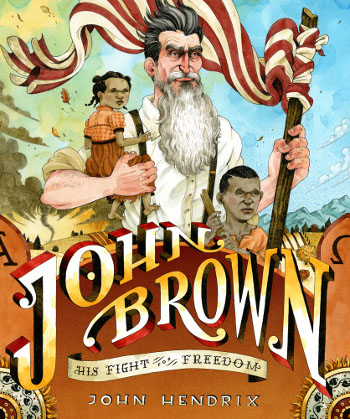 John, who visited 7-Imp on a Sunday early this year, studied at the School of Visual Arts; has done book covers; has done work for the New Yorker, Rolling Stone, and the New York Times; teaches illustration at Washington University; and illustrated last year’s Abe Lincoln Crosses a Creek by Deborah Hopkinson. But these illustrations today are from the first book John has both written and illustrated, John Brown: His Fight for Freedom, to be released by Abrams in early October.
John, who visited 7-Imp on a Sunday early this year, studied at the School of Visual Arts; has done book covers; has done work for the New Yorker, Rolling Stone, and the New York Times; teaches illustration at Washington University; and illustrated last year’s Abe Lincoln Crosses a Creek by Deborah Hopkinson. But these illustrations today are from the first book John has both written and illustrated, John Brown: His Fight for Freedom, to be released by Abrams in early October.
In fact, I’ve seen a handful of such good picture book biographies lately, just released or about to be released, that I’m unofficially declaring this week Picture Book Biography Week…er, inasmuch as I ever plan ahead at this blog…which is sort of not really that far in advance. More like, hmm, let me consult my 7-Imp chicken-scratch notes—a.k.a. My System of Organization—and see what I can scrounge up for next week. Fortunately, it always seems to work out. We’ll see if I can pull off another picture book biography this week. I think I can!
So. Back to Hendrix’s biography of John Brown, one of the most controversial figures in American history. The book is a force of nature, I tell ya. (That is not intended to be a really bad pun of the spread opening this post. Promise.)
Hendrix gives us here the adult life of white abolitionist John Brown, looking larger than life, as you can see from these illustrations. The book opens with his life in small-town Hudson, Ohio: “He and his family loved and respected their free black neighbors. They would often invite them over for dinner”:
by their proper names, and not by their first names or nicknames
like many white people would do.”
(Click to enlarge.)
Hendrix covers Brown’s work for the Underground Railroad, explaining how he ran stops with his father, also an abolitionist.
even if that neighbor was different from them.”
(Click to enlarge.)
After describing personal moments in John’s life (offering his front pew seats in church to a black family, thus angering his church and getting kicked out), as well as the inspiration behind the formulation of John’s “plan of grand liberation” and his first meeting with Frederick Douglass, Hendrix addresses the 1854 Kansas-Nebraska Act and the existence of the “Border Ruffians,” or pro-slavery activists, followed by John’s first meeting with his “greatest ally,” Harriet Tubman.
(Click to enlarge.)
(Click to enlarge. I love this hand-drawn text.)
Hendrix writes, as he introduces John’s controversial raid on Harpers Ferry, Virginia, “John did not believe bloodshed was the answer, but he knew the key to his plan was to capture the country’s attention with a big bang.” Planning to raid a large federal armory and take more than one hundred thousand rifles, he aimed to send a “signal to all the Southern slaves that the fight for freedom has started!”
(Click to enlarge.)
Yet, things did not go as planned. John’s plans were thwarted by a train full of many passengers, heading to Baltimore, which had pulled into Harpers Ferry. John was not willing to take all the passengers as hostages…
(Click to enlarge.)
(Click to enlarge.)
Eventually, when the U.S. Marines demanded a surrender, yet John refused, John and his raiders were outnumbered. In one emotional, dramatic spread, Hendrix brings to life the moment in which Lieutenant Israel Green draws his sword to stop Brown, yet his sword bent in half. Afterwards, John is taken to trial and hanged for insurrection, conspiracy, and high treason.
What I’ve just relayed here to you are (some of) the facts of John Brown’s adult life, as laid out in the biography, but what I hope you can see from the illustrations is the drama inherent in John’s work. (Thank the stars for illustrators who share their work when I go knockin’ at their cyber-door. The art says more than I ever could.) His bold perspectives and Paul-Bunyanesque, purposely off-kilter proportions make for an exciting, visually-arresting read. In a March interview over at Art Director Chad Beckerman’s excellent blog, Mishaps and Adventures, John wrote, “We must remember, as illustrators, that our primary goal is not expression, but communication. That is why learning how to use 2-D design skills like hierarchy, scale-shift, figure/field relationships are really helpful to learn about communication. We have to strive for not just interest but clarity.”
And the writing? As John writes in the closing Author’s Note,
John Brown has been a source of controversy for more than 150 years. In difficult times, men were forced to make difficult choices. When faced with the horrors of slavery, John could not bear the thought of inaction. This book is my interpretation of how a man who saw violent oppression chose to fight it, no matter the consequence. His decision to wage war on slavery in America made him an outlaw and ultimately cost him his life. But I often think that his role in American history is often misunderstood….While reading about {John’s} events, I often asked myself, if I saw my neighbors threatened, my family terrorized, and my dearest friends hauled away in chains, what would I do?…{John Brown} would not make a truce with injustice. Now, no man is perfect, and John was no exception. His ambitious plan to free the slaves was a spectacular failure. But though the United States hanged him as a traitor, I feel we must not dismiss him as a madman. Terrorists crave destruction and turmoil, and the seed of John’s rebellion was compassion.
Here we have an author taking a controversial figure, doing his research on said figure (select sources—and even an index—are included), and proffering his interpretation of that man’s choices, ones that led to death and destruction. And he provides us an author’s note that asks us to consider his interpretation, while also inherently encouraging young readers to think for themselves. The book, as a whole, also embodies the “value in talking to children about the nature of human conflict and the nature of evil,” as John puts it over there at Chad’s blog. I like that just about as much as I like John’s art.
For another interesting read on this title, visit Chad’s other post (from February of this year) on this same title, “The Evolution of a Picture Book Cover, Starring JOHN BROWN.”
JOHN BROWN: HIS FIGHT FOR FREEDOM. © 2009 by John Hendrix. Published by Abrams Books for Young Readers, New York, New York. Images reproduced by permission of the author/illustrator. All rights reserved.
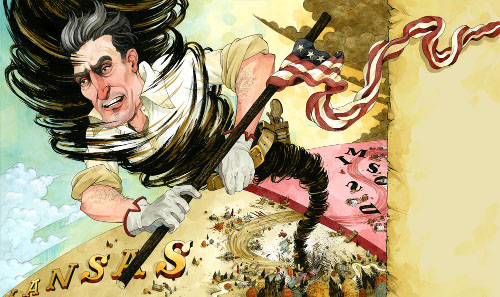
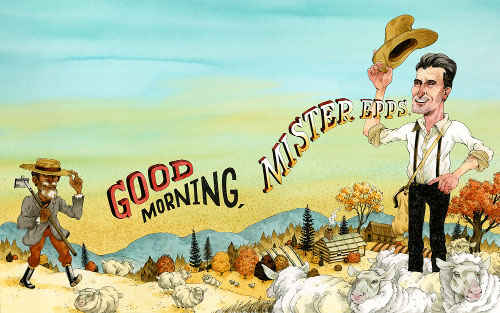
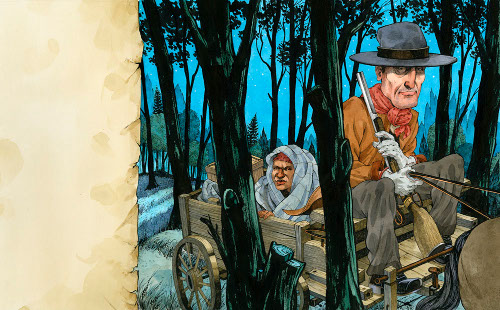
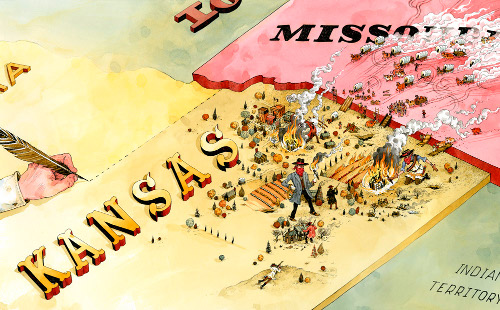
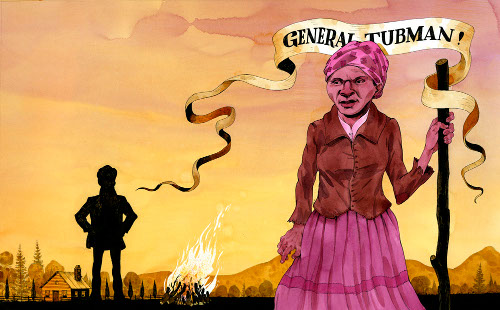


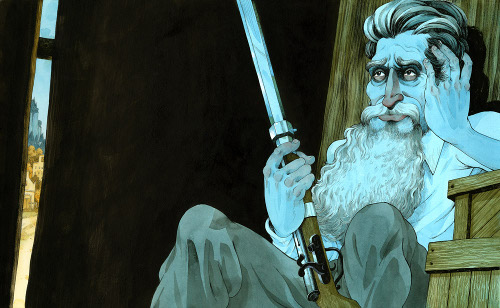

I have read a lot of fiction, fact, and fancy about John Brown — a LOT. And yet, the larger-than-life, braggadocio in this artwork seems to describe him in appealing, John Bunyanesque ways that help align the spectacular failure of his rebellion to the spectacular audacity of his dreams.
SO, he tried and failed. How often do we have picture books about the ones who only were able to try and not succeed? NEVER. That’s another reason this is astoundingly awesome. A reminder to at least try…
[Aside: Bruce Campbell was exactly who I thought of, too!]
In the last link you provided, I loved Chad’s description of how an early cover rendering was rejected: “It made [Brown] look Joaquin Phoenix / Una bomber crazy. This had to change. I suggested thinking of Superman crossed with Moses.” And I love the (unintentional?) way in which the last illustration above (“The unfolding events…”) recalls, for me anyhow, some of the photos of Lincoln taken when things were at their absolute worst. Now, that is somebody who’s hit rock bottom.
As tanita says, this looks astoundingly awesome — both in what it set out to do and in what it does.
(I didn’t know Brown lived in Hudson OH. One of my sisters and her family lived there for a few years in the mid-’80s — she’s a history buff and never said a word about it to me. Always looking for reasons to go one-up on the sister in question, so thanks.)
Tanita, ooo! ooo! Yes, you nailed it — about the failure, that is. Thank goodness for 7-Imp readers. YES, I knew there was something else. It was on the tip of my tongue. Showing failure, yet also that the seed of that failed rebellion was compassion (as Hendrix put it), is rare, indeed. For a picture book.
John, always glad to help you one-up a sibling. And yeah, I liked reading that post about the cover, too. I have GOT to GOT TO have Chad Beckerman over here already one day to chat about his work.
“Good Morning, Mr. Epps.” Ooh, love that hand drawn text, too!
This definitely looks awesome and then some. Love what John says about the goal of illustrators — not just expression but communication. Spot on!!
Oh, I’m interested in this one. I don’t know huge amounts about John Brown, but I’ve been paying more attention to him since I visited Harpers Ferry some years back. I’m not at all sure what I think of him myself.
And the thing about Bruce Campbell is that he is always here and there.
[…] Seven Impossible Things Before Breakfast a blog about books « An Illustrator I Like to Watch These Days […]
I’d like to send this parcel to pre-teen sex photos video To Me Dis Was Not Hot.The Boy Was Cute Though, But I Dont Thing He Could Handle All That Action.
pre-teens pornography gallery cytherea is queen! i used to see a girl who squirted like her. think thats why i like her so much. her every mannerism when she cums is like that tight wet gushing girl
Very interesting tale you tube boys pre-teen Couldn’t imagine better sex with an asian. She gives great head, offers her ass and takes a load like a champ, A+.
young pre-teen girl models It’s because of the government, which doesn’t allow it. They do allow sperm to be seen, hence why bukake was invented and why they have so many of those.
How much will it cost to send this letter to ? world nude model Very beautiful, romantic, like it, just touch, not like a lot of objects, like touching, kissing and cuddling, I loved the video
childmodel toplist here there are many videos but i think they are lacking the heat the love wish to see more acting from them
I’d like to pay this in, please free model gallerie my dick is so hard im pratically cuming all over my roof its drippin down on to my oily scalp i feel like im having a shower its so nice and relaxing mmmmmmmmmmmmmmmmmmmmmmmmmmmmmmmmmm
vlads models this girl showing her tits makes her look so sexy shes veryy hot and look ssexy while she sucks on cock
[…] Artist: John HendrixSource: http://blaine.org/sevenimpossiblethings/?p=1778 […]
lovely post